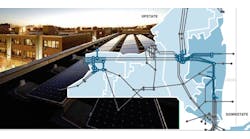Microgrids are too expensive, the renewable energy component is not dependable and microgrids are no better than backup generators. These are the top three microgrid misconceptions that prevent businesses from installing microgrids, say providers of the technology.
In addition, customers mistakenly believe that the technology is immature and complex. And they say microgrids aren’t flexible enough.
Without question, the number one misconception is about high cost, and microgrid providers provide plenty of fodder to shoot down that idea.
Sean McEvoy, senior vice president of business development at Veritone, said, “The cost of renewables, especially solar and battery power, has plummeted to the point where microgrid projects are now feasible and make financial sense. Beyond the cost of the equipment itself, though, consider the cost of doing nothing. Power outages and interruptions cost Americans at least $150 billion each year.”
Tony Soverns, chief technology officer at Go Electric, agreed that equipment costs have decreased dramatically in the last few years and are expected to drop rapidly as more standardized solutions become available. Lower total costs will open up new markets, he said.
Microgrid misconceptions about compensation
In addition, the many incentives available for energy storage and renewables help defray the cost, said Amanda Kabak, chief technology officer and principal architect for CleanSpark. They include federal investment tax credits and California’s self-generation incentive program.
“Even if your load profile is fairly flat, you may be able to leverage a microgrid for utility cost savings,” she added.
Allan Schurr, chief commercial officer at Enchanted Rock, countered the “too expensive” argument by pointing to the potential for owners to be compensated for energy from microgrids.
“The virtue of a microgrid is the economics. A microgrid connects to the grid and is compensated for providing grid stability service — resulting in an additional revenue stream that offsets costs,” he said.
In many markets, Enchanted Rock has seen compensation as high as $100 to $200 per kW/year.
In addition, hybrid microgrids allow customers to mix and match technologies based on cost, footprint, regulations and resiliency requirements, said Schurr.
“As we integrate more renewables into the grid, natural gas or renewable natural gas is an attractive option for fast start, fast ramp dispatchable power when contingent capacity is needed. This ability is especially advantageous when you compare a 10 second microgrid start time to several hours for a combined cycle gas turbine,” he said.
What’s more, financing options are available that help buyers, said the microgrid providers. These include energy as a service, which are long-term agreements under which no capital is provided by the customers. Under this arrangement, the service provider assumes the risk of ownership related to the equipment, and payments to the provider are contingent on achievement of established outcomes.
AI has changed the game
By Phonlamai Photo/Shutterstock.com
The second misconception is that renewable energy in microgrids is too unpredictable.
In response, Veritone’s McEvoy said, “While renewable energy sources are inherently unpredictable, the microgrid orchestrating all of them doesn’t have to be.”
Day-ahead forecasting methods are used today to mitigate this risk. However, the amount of wind and sunlight changes within minutes, making them less useful when these types of clean energy sources are in the mix, he said. But artificial intelligence (AI) solves this problem. It can provide real-time predictive models for power dispatch and storage. These models constantly update for each device in the microgrid, sharing that status with every other device. They all send control signals to each other to ensure all devices are meeting demand all the time.
“This AI-based modeling and control makes the unpredictable nature of microgrid energy sources more manageable and the overall microgrid more reliable,” said McEvoy.
Along the same lines, Go Electric’s Soverns noted that many mistakenly believe microgrids can’t have a high renewable content. But new technologies and higher current DC-DC converters, plus advancements in control systems, allow for very high levels of renewable energy in microgrids.
“The renewable penetration limit is not contingent on technology but rather the practical economic limits of protecting against every possible scenario,” he said. For example, understanding the amount of battery storage required to provide power for many hours or days with little to no renewable production makes it challenging to size renewable systems appropriately, he said.
Myths about fuels, complexity, maturity
Industry leaders also hear prospective customers mistakenly equate microgrids with backup generators.
“Because they’ve long been the standard solution, there is a misconception that diesel generators are the optimal fuel source for backup requirements in terms of affordability and quick start capability,” said Enchanted Rock’s Schurr. But that’s no longer true, according to Schurr. Microgrid technology using cleaner fuel sources, such as natural gas or renewable natural gas, can also support quick start and transient load, but without high emissions. What’s more, natural gas is available through an underground network, while refueling on-site diesel supplies can be impossible during extended outages when supply routes aren’t accessible.
Microgrids also offer far more services than backup generation. And unlike backup generators, microgrids operate 24/7, so they are constantly maintained. In many cases, backup generators are turned on only during an emergency, a bad time to discover the generator needs repairs or replacement.
By naulicrea/Shutterstock.com
Another misconception microgrid providers cite: Microgrids are too complex.
Jason Heindel, solutions architect for Azzo, said the core of a microgrid system is the same type of electrical distribution equipment common in any facility.
“It may have slightly additional features and capabilities, but it really isn’t much different than distribution equipment that would be designed by a consulting engineer for a new building,” he said. Using off-the-shelf, well developed and established products and systems will reduce the “too complex” fear, he added.
Learn more at Microgrid 2021: The World Awakens to Microgrids, a virtual conference hosted by Microgrid Knowledge over eight days in May and June. Registration is free if you sign up in advance. Space on the platform is limited.
In addition, customers mistakenly say microgrids aren’t flexible enough.
Chris Ball, Bloom Energy product marketing lead, said customers believe microgrids aren’t flexible enough for their complex energy requirements. While each business has unique power needs, microgrids can integrate many on-site generating technologies, including fuel cells, solar, wind, batteries and generators into a single on-site solution.
“The modularity of microgrids can grow and scale with the ebbs and flows of a business, allowing for unprecedented flexibility in how a company addresses their complex energy needs over the long term,” Ball said.
Some customers say the technology is immature. That might have been true five years ago when many microgrid projects were not much more than demonstration projects, said Soverns.
“Today we are seeing most microgrid projects are commissioned successfully and remain as functioning systems,” Soverns said. That’s because the last five years have seen major improvements in microgrid design and technology, including photovoltaics, batteries, power conversion systems, power management systems, energy management systems and distribution systems, he added.
To these providers, such misconceptions stand in the way of seeing more microgrids built, and customers need to be educated about these misleading and unfounded ideas.
By Tada Images/Shutterstock.com
What does an outage cost?
As for the top misconception — that microgrids are too expensive — Azzo’s Heindel stresses that customers don’t focus enough on the value of a microgrid’s key benefit: Its ability to provide resilience.
“The fundamental question is what the financial impact to a facility or operation is if there is an extended utility outage. Business needs to start thinking beyond just sustainability,” Heindel said.
What microgrid misconceptions do you run into? Please post your thoughts in our LinkIn Group, Microgrid Knowledge.








